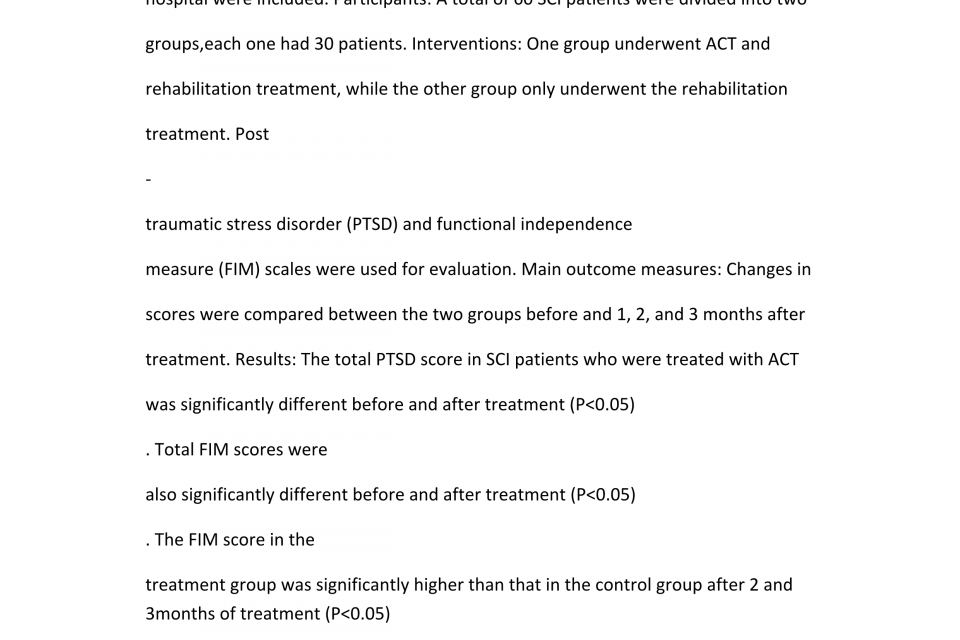Datasets
Standard Dataset
Effect of acceptance and commitment therapy on rehabilitation patients with spinal cord injury
- Citation Author(s):
- Submitted by:
- Huang Gang
- Last updated:
- Wed, 12/11/2019 - 19:36
- DOI:
- 10.21227/5a66-ah35
- Data Format:
- License:
 79 Views
79 Views- Categories:
- Keywords:
Abstract
Abstract Objective: This study aimed to explore the differences between the combination of rehabilitation with acceptance commitment therapy (ACT) and rehabilitation therapy alone in the treatment of spinal cord injury (SCI). Setting: SCI patients admitted to a hospital were included. Participants: A total of 60 SCI patients were divided into two groups,each one had 30 patients. Interventions: One group underwent ACT and rehabilitation treatment, while the other group only underwent the rehabilitation treatment. Post-traumatic stress disorder (PTSD) and functional independence measure (FIM) scales were used for evaluation. Main outcome measures: Changes in scores were compared between the two groups before and 1, 2, and 3 months after treatment. Results: The total PTSD score in SCI patients who were treated with ACT was significantly different before and after treatment (P<0.05). Total FIM scores were also significantly different before and after treatment (P<0.05). The FIM score in the treatment group was significantly higher than that in the control group after 2 and 3months of treatment (P<0.05). Conclusion: The combination of rehabilitation therapy and ACT could immediately reduce stress levels and significantly improve impaired function, lifelong self-care ability, and the effect of rehabilitation therapy.
Figure A and B: A:▲:Comparison of total PTSD scores of the treatment group within before and after 1, 2 and 3 months treatment(P<0.01).▼:Comparison of total PTSD scores between treatment group and control group(P<0.01).■:Look at the control group, there was no significant difference between before treatment and 1 month after treatment(P>0.05), but there was significant difference in the 2 months after treatment(P<0.05), and the difference was more significant in the 3 months after treatment(P<0.01). B: ▲:Comparison of the total FIM scores of the treatment group before and after 1, 2 and 3 months treatment(P<0.01).▼:Comparison of total FIM scores between treatment group and control group(P<0.01).■:Comparison of total PTSD scores of the control group before and after treatment in 1, 2 and 3 months(P<0.01). Data expressed as mean ± standard error (SEM) Figure C The modified Barthel Index according to FIM scale was correlated with the total score of PTSD, and the data was expressed as mean ± standard error (SEM) * P < 0.05, * * P < 0.01.









